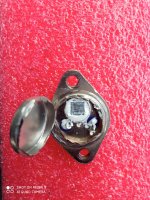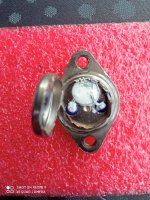Bnjour a tous sur la version JlH 1969 j'avais remplacé les 2n3055 par des mj15003 ils ont grillé j'ai remonté les 2n3055 et ça a remarché. peur qu'ils grillent comme sur le premier ampli donne mois votre avis s'il vous plaît merci
TRANSLATION said:Hello everyone on the JlH 1969 version I replaced the 2n3055 with mj15003 they fried I reassembled the 2n3055 and it worked again. afraid that they burn out like on the first amp give me your opinion please thank you
 Merci de poster en anglais
Merci de poster en anglaiswhich version of the JLH69? (kit or P2P or personal pcb?)
where did you buy your 15003?
No problem with these on the original schematic .
where did you buy your 15003?
No problem with these on the original schematic .
I had bought two kits from Aliexpress when replaced the 2n3055 with 15003 they have blown now have mounted .the 2003 version with pcbs bought on eBay the amp works very well but i would like to replace the 2n3055 with mj15003 but i am alfraid that they will burn out too
Duffo adele, do you recommend buying a JLH kit from Aliexpress? Which kit (or kits) do you advise?
I made this comment on another thread, but I will repeat it here: that design has poor control over its output bias current. The bias current depends on HFE. It is much less stable than in good designs.
I suggest not burning out more transistors by choosing a better design.
Ed
I suggest not burning out more transistors by choosing a better design.
Ed
monté le jlh 1969 avec des kits de chez aliexpress mais avec des composants achetés dans un magasin d'électronique et j'ai été très satisfait du résultat
Built the jlh 1969 with kits from aliexpress but with components purchased from an electronics store and I was very satisfied with the result
 diyAudio is an English language forum. Please post in English or provide a translation. diyAudio est un forum de langue anglaise. Veuillez poster en anglais ou fournir une traduction.
diyAudio is an English language forum. Please post in English or provide a translation. diyAudio est un forum de langue anglaise. Veuillez poster en anglais ou fournir une traduction.
Built the jlh 1969 with kits from aliexpress but with components purchased from an electronics store and I was very satisfied with the result
 diyAudio is an English language forum. Please post in English or provide a translation. diyAudio est un forum de langue anglaise. Veuillez poster en anglais ou fournir une traduction.
diyAudio is an English language forum. Please post in English or provide a translation. diyAudio est un forum de langue anglaise. Veuillez poster en anglais ou fournir une traduction.
Last edited by a moderator:
There's about a million threads about the JLH amp: are you going to repeat the same biased 😉 opinion every time?I made this comment on another thread, but I will repeat it here:
I assembled several jlh69, I tortured more than one, I have one that has literally been in operation for almost ten years (I had to stop it maybe 5 times) and I never managed to destroy one.I made this comment on another thread, but I will repeat it here: that design has poor control over its output bias current. The bias current depends on HFE. It is much less stable than in good designs.
I suggest not burning out more transistors by choosing a better design.
Ed
The MJ15003 has a higher gain than the 2N3055, and so will need higher value resistors in the driver stage. Are you setting the current up correctly in the first place?
However, the MJ15003 datasheet shows that there may indeed be a problem with this choice of transistor. At 25C the gain peaks at around 60 at 800mA, then drops at higher current. Unfortunately the gain increases with temperature to about 80 at 1A, so the gain increase with temperature is greater than the gain reduction due to roll-off effects. That means it is not as stable, but that problem can be ameliorated if large enough heatsinks are used (and the devices and PSU are arranged to be able to operate at the elevated temperature and corresponding gain).
It's a point I discussed with the 2N3055. The original RCA transistor (hometaxial) was stable because there was no significant gain change with temperature for currents ver 1A - in fact, the datasheets showed that the gain falls faster at higher temperatures as well as falling due to gain-roll-off effects (high level injection). That is a moot point now, because the original hometaxial device is obsolete and devices currently will be a version of epi base.
So as long as you are able to set the current to the correct value after switching on - with proper adjustment of the resistors - and have a suitable heatsink, the MJ15003 may well increase in current with time as it warms up, but a large heatsink should prevent too great a current swing.
The JLH modified design using a current source instead of a bootstrap would help, too, if you use a transistor to limit the current in the current source. If that current sensing transistor is mounted on the heatsink it will provide a degree of thermal compensation.
It may also be that you have poor copies (fake) MJ15003's. Often fake devices are smaller than they should be and may suffer greater heating or degradation as a result.
However, the MJ15003 datasheet shows that there may indeed be a problem with this choice of transistor. At 25C the gain peaks at around 60 at 800mA, then drops at higher current. Unfortunately the gain increases with temperature to about 80 at 1A, so the gain increase with temperature is greater than the gain reduction due to roll-off effects. That means it is not as stable, but that problem can be ameliorated if large enough heatsinks are used (and the devices and PSU are arranged to be able to operate at the elevated temperature and corresponding gain).
It's a point I discussed with the 2N3055. The original RCA transistor (hometaxial) was stable because there was no significant gain change with temperature for currents ver 1A - in fact, the datasheets showed that the gain falls faster at higher temperatures as well as falling due to gain-roll-off effects (high level injection). That is a moot point now, because the original hometaxial device is obsolete and devices currently will be a version of epi base.
So as long as you are able to set the current to the correct value after switching on - with proper adjustment of the resistors - and have a suitable heatsink, the MJ15003 may well increase in current with time as it warms up, but a large heatsink should prevent too great a current swing.
The JLH modified design using a current source instead of a bootstrap would help, too, if you use a transistor to limit the current in the current source. If that current sensing transistor is mounted on the heatsink it will provide a degree of thermal compensation.
It may also be that you have poor copies (fake) MJ15003's. Often fake devices are smaller than they should be and may suffer greater heating or degradation as a result.
Friends of mine also thought that any old TO3 power transistors would work in the original design but not so. Using the amplifiers at near max. ratings soon caused overheating and failure with MJ15003 and others. Large heatsinks helped to prolong output transistor life but they're expensive and it's hard to find suitable types for your particuar case/box.
For full rated power, the heatsink or sinks need to be larger than you see in many kit and complete JLH amplifier advertisements. They generally need to be rated at no more than 1.0K/W thermal resistance for each channel when used in warm locations and climates, where they will be operating at uncomfortably hot temperatures. It's not difficult to measure your heatsink's performance (e.g. see Randy Slone's "High power audio amplifier construction manual") but if you don't already have the transistors, this rough method of estimation may be a little better than a wild guess: https://celsiainc.com/resources/calculators/heat-sink-size-calculator/
For full rated power, the heatsink or sinks need to be larger than you see in many kit and complete JLH amplifier advertisements. They generally need to be rated at no more than 1.0K/W thermal resistance for each channel when used in warm locations and climates, where they will be operating at uncomfortably hot temperatures. It's not difficult to measure your heatsink's performance (e.g. see Randy Slone's "High power audio amplifier construction manual") but if you don't already have the transistors, this rough method of estimation may be a little better than a wild guess: https://celsiainc.com/resources/calculators/heat-sink-size-calculator/
@ John and Ian
Good analysis but how many jlh69 amps have you assembled and used ?
It turns out that the recycled 2U chassis that I used for years as a torture bench is anything but optimal in terms of heatsinks, which I played with several output transistors and several supply voltages and several bias currents and the only times I had a thermal runaway was because of modern and too fast output devices.
On the other hand, we do not know how the bias of the OP amplifier is adjusted or at what supply voltage or if which heatsinks it is assembled or on what load it operates.
But please, don't say that the MJ15003 poses a problem, it is precisely this output set that I chose for my amp which has been running almost 24/24 365 for ten years with 23V dc 1.4A bias and I am very far from be the only one to have chosen these output transistors.
Good analysis but how many jlh69 amps have you assembled and used ?
It turns out that the recycled 2U chassis that I used for years as a torture bench is anything but optimal in terms of heatsinks, which I played with several output transistors and several supply voltages and several bias currents and the only times I had a thermal runaway was because of modern and too fast output devices.
On the other hand, we do not know how the bias of the OP amplifier is adjusted or at what supply voltage or if which heatsinks it is assembled or on what load it operates.
But please, don't say that the MJ15003 poses a problem, it is precisely this output set that I chose for my amp which has been running almost 24/24 365 for ten years with 23V dc 1.4A bias and I am very far from be the only one to have chosen these output transistors.
Sample of many and many pages on the net .Most likely the transistors are fake. Open one and show everyone the crystal. Similarly, this
https://sound-au.com/fake/counterfeit-p1.htm
I must add that I did not play long with the 2003 because I did not like the sound and that it is possible that with this version, things can change.
I only speak for the original 69 schematic
I only speak for the original 69 schematic
@ Huggygood
The shematics you posted looks like the 2003. Is your original single or double voltage, single or double ouput pairs?
The shematics you posted looks like the 2003. Is your original single or double voltage, single or double ouput pairs?
- Home
- Amplifiers
- Solid State
- MJ15003 transistors that burn out


